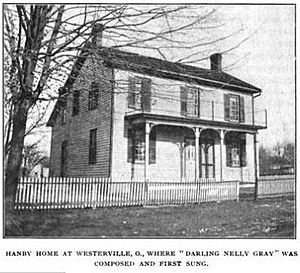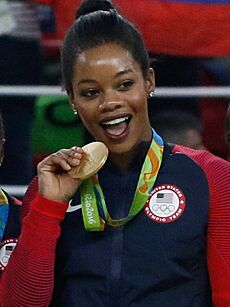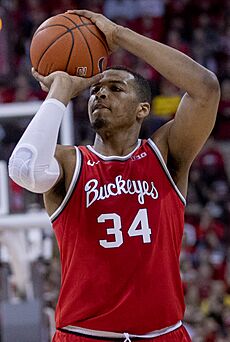Westerville, Ohio facts for kids
Quick facts for kids
Westerville, Ohio
|
|
|---|---|
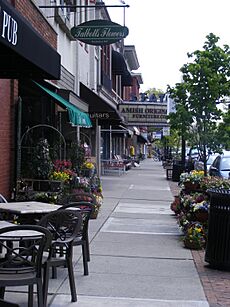
State Street in Westerville
|
|
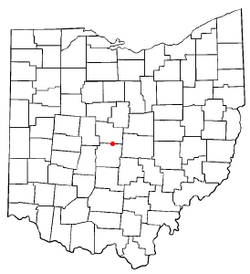
Location of Westerville in Ohio
|
|
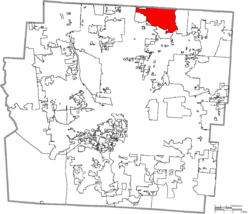
Location of Westerville in Franklin County
|
|
| Country | United States |
| State | Ohio |
| Counties | Delaware, Franklin |
| Incorporated | 1858 |
| Area | |
| • Total | 12.74 sq mi (33.00 km2) |
| • Land | 12.60 sq mi (32.64 km2) |
| • Water | 0.14 sq mi (0.36 km2) |
| Elevation | 879 ft (268 m) |
| Population
(2020)
|
|
| • Total | 39,190 |
| • Density | 3,109.82/sq mi (1,200.74/km2) |
| Time zone | UTC-5 (EST) |
| • Summer (DST) | UTC-4 (EDT) |
| ZIP codes |
43081, 43082, 43086
|
| Area code(s) | 614 and 380 |
| FIPS code | 39-83342 |
| GNIS feature ID | 1086118 |
Westerville is a city in Ohio, a state in the United States. It is located in Franklin and Delaware counties. Westerville is a suburb northeast of Columbus. It is also home to Otterbein University. In 2020, about 39,190 people lived there.
Westerville was once called "The Dry Capital of the World." This was because of its strict rules against selling alcohol. It was also the home of the Anti-Saloon League. This group helped bring about Prohibition in the early 1900s. Prohibition was a time when alcohol was illegal in the U.S.
Contents
History of Westerville
Early Inhabitants
People have lived in the Westerville area for thousands of years. Very old groups, called Paleo-Indians, lived here. Later groups also lived between Big Walnut Creek and Alum Creek. When Europeans arrived, the Wyandot were the main group living along Alum Creek. They had to leave Ohio in 1843.
Founding and Growth
People from Europe started settling in the Westerville area around 1810. In 1818, the Westervelt family moved here from New York. Matthew Westervelt gave land to build a Methodist church in 1836. The settlement was then named after his family.
In 1839, a school called Blendon Young Men's Seminary started in Westerville. Matthew Westervelt was one of its first leaders. The Church of the United Brethren in Christ bought the school in 1846. The next year, the school was renamed Otterbein College. It was named after the church's founder, Philip William Otterbein. Today, it is a private school called Otterbein University.
Westerville was officially set up as a town by 1856. It became a city in August 1858. At that time, only 275 people lived there.
The Underground Railroad and Benjamin Hanby
Before the American Civil War, several homes in Westerville were part of the Underground Railroad. This was a secret network that helped enslaved people escape to freedom. One of these homes is the Hanby House. It is very close to Otterbein University.
Benjamin Russell Hanby moved to Westerville in 1849. He was 16 and came to study at Otterbein University. Hanby wrote many famous songs. These include "Darling Nelly Gray" (which showed his feelings for enslaved people), "Who is He in Yonder Stall?", and the Christmas song "Up On The Housetop".
His home in Westerville is now a museum. It is listed on the National Register of Historic Places. It opened as a museum in 1937. The Ohio Historical Society owns it, and the Westerville Historical Society manages it. It is the only state memorial in Ohio for a composer.
Westerville's "Dry Capital" Era
In 1859, Westerville passed a law that banned selling alcohol. By the 1870s, there were big fights between people who wanted alcohol and those who didn't. These were called the "Westerville Whiskey Wars." Twice, in 1875 and 1879, a businessman named Henry Corbin opened a saloon. Both times, people in the town blew up his business with gunpowder.
Westerville became very famous for its anti-alcohol stance. In 1909, the Anti-Saloon League moved its main office to Westerville. This group was a big part of the Prohibition movement. They achieved a huge victory when the Eighteenth Amendment to the United States Constitution was passed in 1919. This amendment made alcohol illegal across the U.S.
The Anti-Saloon League printed so many flyers and papers supporting Prohibition. They sent out over 40 tons of mail every month! Because of this, Westerville was the smallest town in the nation to have a first-class post office. It was known as "The Dry Capital of the World."
In 1973, the League's Westerville office became part of the Westerville Public Library. It now serves as a museum connected to the library. Even after Prohibition ended, Westerville remained mostly "dry" for many years.
Westerville Today
In 1916, Westerville was the first village in Ohio to use a council-manager system. In this system, a city council makes the rules. But the daily running of the city is handled by a professional manager. Westerville still uses this system today.
The city elects seven council members. They serve for four years. The council chooses one of its members to be the mayor. The mayor is mostly a ceremonial leader. The council also picks the city manager, who runs the city's day-to-day operations.
In 1995, Westerville added 941 acres of land to its north. This land was not "dry" and had businesses that sold alcohol. Since then, voters have approved alcohol sales in some parts of old Westerville. In 2006, Michael's Pizza was the first place in Uptown Westerville to serve beer in over 70 years.
On October 15, 2019, Westerville hosted a big event. It was the fourth 2020 Democratic Primary Presidential Debate. More than 12 candidates were on stage. This was the largest primary debate in American history. In 2020, Westerville was named the best suburban city in America. This was based on a study that looked at things like cost of living and safety.
Geography
Westerville covers about 12.61 square miles (32.61 square kilometers). Most of this area is land, with a small part being water.
Climate
| Climate data for Westerville, Ohio, 1991–2020 normals, extremes 1897–present | |||||||||||||
|---|---|---|---|---|---|---|---|---|---|---|---|---|---|
| Month | Jan | Feb | Mar | Apr | May | Jun | Jul | Aug | Sep | Oct | Nov | Dec | Year |
| Record high °F (°C) | 70 (21) |
77 (25) |
85 (29) |
88 (31) |
95 (35) |
100 (38) |
103 (39) |
101 (38) |
101 (38) |
93 (34) |
81 (27) |
76 (24) |
103 (39) |
| Mean maximum °F (°C) | 59.5 (15.3) |
63.3 (17.4) |
72.7 (22.6) |
81.5 (27.5) |
87.7 (30.9) |
92.4 (33.6) |
92.6 (33.7) |
91.9 (33.3) |
89.9 (32.2) |
82.4 (28.0) |
69.8 (21.0) |
64.6 (18.1) |
93.8 (34.3) |
| Mean daily maximum °F (°C) | 37.7 (3.2) |
42.0 (5.6) |
52.6 (11.4) |
66.3 (19.1) |
75.5 (24.2) |
83.2 (28.4) |
85.9 (29.9) |
84.6 (29.2) |
79.1 (26.2) |
67.3 (19.6) |
53.4 (11.9) |
42.1 (5.6) |
64.1 (17.9) |
| Daily mean °F (°C) | 29.9 (−1.2) |
33.0 (0.6) |
42.3 (5.7) |
54.1 (12.3) |
63.9 (17.7) |
72.2 (22.3) |
75.4 (24.1) |
73.8 (23.2) |
67.6 (19.8) |
56.0 (13.3) |
44.2 (6.8) |
34.6 (1.4) |
53.9 (12.2) |
| Mean daily minimum °F (°C) | 22.0 (−5.6) |
24.0 (−4.4) |
31.9 (−0.1) |
41.9 (5.5) |
52.4 (11.3) |
61.1 (16.2) |
64.9 (18.3) |
63.1 (17.3) |
56.0 (13.3) |
44.7 (7.1) |
34.9 (1.6) |
27.0 (−2.8) |
43.7 (6.5) |
| Mean minimum °F (°C) | −1.8 (−18.8) |
2.9 (−16.2) |
12.3 (−10.9) |
25.2 (−3.8) |
35.7 (2.1) |
46.0 (7.8) |
53.2 (11.8) |
51.6 (10.9) |
41.2 (5.1) |
29.2 (−1.6) |
18.7 (−7.4) |
8.8 (−12.9) |
−4.8 (−20.4) |
| Record low °F (°C) | −27 (−33) |
−25 (−32) |
−10 (−23) |
13 (−11) |
23 (−5) |
30 (−1) |
41 (5) |
36 (2) |
29 (−2) |
16 (−9) |
−9 (−23) |
−25 (−32) |
−27 (−33) |
| Average precipitation inches (mm) | 2.93 (74) |
2.36 (60) |
3.42 (87) |
3.91 (99) |
4.22 (107) |
5.02 (128) |
4.56 (116) |
3.64 (92) |
3.29 (84) |
2.95 (75) |
2.88 (73) |
3.05 (77) |
42.23 (1,072) |
| Average snowfall inches (cm) | 6.9 (18) |
5.3 (13) |
2.8 (7.1) |
0.1 (0.25) |
0.0 (0.0) |
0.0 (0.0) |
0.0 (0.0) |
0.0 (0.0) |
0.0 (0.0) |
0.0 (0.0) |
0.5 (1.3) |
3.4 (8.6) |
19.0 (48) |
| Average precipitation days (≥ 0.01 in) | 13.3 | 10.9 | 12.4 | 13.6 | 13.7 | 12.0 | 11.5 | 9.4 | 9.0 | 10.6 | 11.1 | 12.6 | 140.1 |
| Average snowy days (≥ 0.1 in) | 6.2 | 4.6 | 1.9 | 0.1 | 0.0 | 0.0 | 0.0 | 0.0 | 0.0 | 0.0 | 0.6 | 3.3 | 16.7 |
| Source 1: NOAA | |||||||||||||
| Source 2: National Weather Service | |||||||||||||
Population of Westerville
| Historical population | |||
|---|---|---|---|
| Census | Pop. | %± | |
| 1860 | 668 | — | |
| 1870 | 741 | 10.9% | |
| 1880 | 1,148 | 54.9% | |
| 1890 | 1,329 | 15.8% | |
| 1900 | 1,462 | 10.0% | |
| 1910 | 1,903 | 30.2% | |
| 1920 | 2,480 | 30.3% | |
| 1930 | 2,879 | 16.1% | |
| 1940 | 3,146 | 9.3% | |
| 1950 | 4,112 | 30.7% | |
| 1960 | 7,011 | 70.5% | |
| 1970 | 12,530 | 78.7% | |
| 1980 | 22,960 | 83.2% | |
| 1990 | 30,269 | 31.8% | |
| 2000 | 35,318 | 16.7% | |
| 2010 | 36,120 | 2.3% | |
| 2020 | 39,190 | 8.5% | |
| Sources: 2020 | |||
2010 Census Information
In 2010, there were 36,120 people living in Westerville. There were 13,859 households and 9,800 families. The city had about 2,896 people per square mile.
About 31.9% of households had children under 18. About 58.7% were married couples. The average household had 2.48 people. The average family had 2.96 people.
The average age in the city was 41.2 years. About 22.4% of residents were under 18. About 10.1% were between 18 and 24. And 14.3% were 65 or older.
Education in Westerville
Otterbein University is a private college in Westerville. It was started in 1847. Today, over 3,000 students attend Otterbein.
Other colleges in Westerville include Hondros College and a branch of Franklin University. There is also Dominion University, The Ohio State School of Cosmetology, and a branch of Columbus State.
The Westerville City School District serves the city. It has three high schools:
- Westerville South High School (opened 1960)
- Westerville North High School (opened 1975)
- Westerville Central High School (opened 2003)
The district also has five middle schools: Blendon, Genoa, Heritage, Minerva Park, and Walnut Springs. There are sixteen elementary schools, including Emerson and Hanby.
Transportation
In the past, Westerville was connected to Columbus by a special road with a toll. Today, Westerville is near Interstate 71 and Interstate 270. These highways connect it to Columbus and other nearby towns.
Westerville is about 16 miles (26 km) from downtown Columbus. It is about 12 miles (19 km) from John Glenn Columbus International Airport. State Route 3 is a main road through the old town center, called Uptown Westerville.
Long ago, streetcars ran through Westerville. But service stopped in 1929. Today, Westerville does not have much public transportation. The city itself does not run buses. However, the Central Ohio Transit Authority (COTA) serves Westerville with five bus lines.
Economy
Several companies have their main offices in Westerville. These include T. Marzetti Company and Mac Tools.
Top Employers in Westerville
Here are the top employers in Westerville, based on a 2023 report:
| # | Employer | # of employees |
|---|---|---|
| 1 | JP Morgan Chase | 3,471 |
| 2 | Mount Carmel Health System | 3,293 |
| 3 | Westerville City Schools | 1,836 |
| 4 | Otterbein University | 1,533 |
| 5 | Central Ohio Primary Care Physician | 1,157 |
| 6 | Exel | 1,058 |
| 7 | OhioHealth | 1,001 |
| 8 | City of Westerville | 887 |
| 9 | ESC of Central Ohio | 828 |
| 10 | Connexions Loyalty Acquisition | 676 |
Notable People from Westerville
Many interesting people have connections to Westerville:
- Tim Bezbatchenko (born 1981) — President for the Columbus Crew SC soccer team.
- Steven Boyer — Theatre and television actor.
- Ki-Jana Carter — A top pick in the 1995 NFL draft for the Cincinnati Bengals.
- The Crimson Armada — An extreme metal band.
- Jim Day — Host of Reds Live for the Cincinnati Reds baseball team.
- Buster Douglas — Former boxing world heavyweight champion.
- Gabby Douglas (born 1995) — A gymnast and 2012 Olympic gold medalist.
- Mark Grimsley (born 1959) — An American historian.
- Benjamin Hanby — A 19th-century composer.
- Nigel Hayes — Professional basketball player in Turkey.
- Jennifer Hetrick — Actor, known for Star Trek: The Next Generation.
- Abhijat Joshi — A Bollywood screenplay writer.
- Andy Katzenmoyer — Football player with the New England Patriots.
- Nick Kellogg — Basketball player for Paris Basketball.
- Bob Kennedy — Two-time Olympian (1992, 1996) in running.
- John William Lambert — An early car maker.
- Perry L. Miles — A U.S. Army brigadier general, born in Westerville.
- Lance Moore — Wide receiver for the Detroit Lions; Super Bowl Champion with the New Orleans Saints.
- Nick Moore — Wide receiver for the Winnipeg Blue Bombers.
- Dan O'Brien — General Manager for the Cincinnati Reds.
- Lauren Schmidt Hissrich (born 1978) — Television writer.
- Caleb Shomo — Former singer of Attack Attack! and founder of Beartooth.
- Benny Snell (born 1998) — Running back for the Pittsburgh Steelers.
- Nick Vannett — Tight end for the New Orleans Saints.
- Kaleb Wesson (born 1999) — Basketball player for Maccabi Rishon LeZion in Israel.
- Andre Wesson (born 1997) — Former basketball player for Ohio State University.
See also
 In Spanish: Westerville (Ohio) para niños
In Spanish: Westerville (Ohio) para niños


